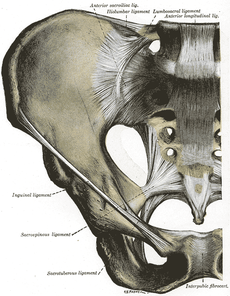Prices in Germany are normally 75% below the cost for treatment of sacroiliitis in the US and are individually quoted. They include all medical expenses, the hospital stay, surgeon's fees, operation room fees, anesthesia, anesthesiologist's fees, medicine, nursing, semi-private room, meals, pre-op diagnosis, local phone and English TV.

Sacroiliitis: Definition
The sacroiliac joint is the joint between the sacrum, at the base of the spine, and the ilium of the pelvis, which are joined by ligaments. Inflammation of this joint is known as sacroiliitis, or SI Joint pain, one cause of disabling low back pain.
Sacroiliitis: Diagnosis
The sacroiliitis or sacroiliac joint dysfunction (SI Joint Dysfunction) can be diagnosed with the Stork Test.
- 1) With the patient standing and the examiner sitting behind, the examiner's left thumb is placed over the most posterior portion of the left posterior superior iliac spine (PSIS) and the right thumb overlying the midline of the sacrum at the same level.
- 2) Examiner asks the patient to flex the left hip and knee to a minimum of 90 degrees of the hip flexion. Imagine making an "L" with the leg and thigh.
- 3) A negative test finds the left thumb on the posterior superior iliac spine (PSIS) moving caudad (towards the tail) in relation to the right thumb on the sacrum.
- 4) The thumb placements are reversed, and the patient is asked to raise the right leg in similar fashion.
- 5) A positive finding occurs when the thumb on the PSIS moves cephalad (towards the head) in relation to the thumb on the sacrum.
- 6) The findings of this test are correlated with those of the standing flexion test. The Stork test is more specific for SI joint Restriction.
- 7) If the patient has difficulty standing on one foot to perform the test, proprioceptive sensory motor balance deficit should be further evaluated.
Sacroiliitis: Treatment
If all non-surgical methods of treatment fail, surgery, usually stronger intervention, may be required.
As a first step after non-surgical treatments fail, in the appropriate patient, injection of autologous stem cells into the SI joint, usually in combination with an analgesic, such as lidocaine. This procedure takes 45 minutes and the cost is approximately 8,000 EUR at this time. Results in our patients have been very good.
SI joint fusion (sometimes called an "arthrodesis") is not a common procedure. It is a proven procedure that can reduce the pain associated with SI joint syndrome. Pain radiating in the back can be a referred pain (coming from another source), caused from diseases like Chron's disease of the intestines. Therefore be absolutely sure that the pain you are experiencing is coming from the SI joint.
In the SI joint fusion is performed by first, the joint is opened and the articular cartilage lining the joint is removed from both surfaces. This creates a fresh surface of sacrum and ilia bone, making them ready for knitting together. The bone surfaces are held together until knit together, or fuse. Without the articular cartilage of the joint, the body treats the two raw bone surfaces just like a fracture.
